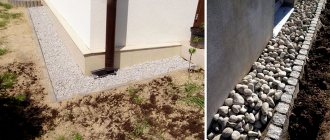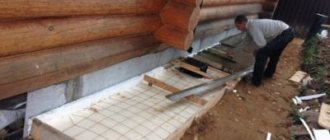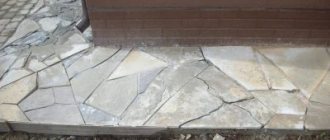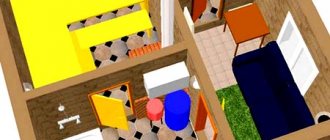In order for a house to be of good quality and attractive, it is necessary not only to monitor the quality of the materials of its construction, but also to take into account the costs of high-quality blind area of the house.
A blind area created in a timely manner and in accordance with all the rules protects the house from rain and flood waters. The paving area looks great. A gravel blind area is durable and functional, but such options are quite complicated to make yourself. If you decide to handle the construction work yourself, the best choice is a blind area made of crushed stone: it looks attractive, is effective and is quite easy to make.
Advantages and disadvantages
A soft blind area, which can be made independently, has negative and positive sides. The advantages of the material include the following facts:
- Unlike conventional materials, the soft blind area is very resistant to ground movements resulting from thawing or freezing of liquid. So, if the base of the building is located below the freezing point of the soil, it remains in a state of immobility. In this case, the protective structure is located above this level. This means that the joint between the blind area and the base will be damaged in spring and winter, regardless of the quality of its execution. Water will penetrate into the holes that form under any conditions. There can only be one way out of this situation: creating additional insulation from water. If it is not possible to bear such costs, soft structures that are resistant to frost are used;
- a soft blind area can protect the structure of a building, improving its exterior. The top layer is made of various materials, so a blind area made of crushed stone will suit any style of building. Plants, including climbing plants, or lawn grass can be planted on the soft blind area;
- When using crushed stone for a blind area, extruded polystyrene foam and its analogues are used as insulation. This material makes it possible to raise the freezing point of the soil near the blind area. This makes it possible to place the base of the structure at a shallower depth.
If we talk about the disadvantages, we should note the mandatory constant maintenance of the top layer of the blind area. For example, decorative backfill needs to be cleaned regularly, and the lawn needs to be mowed several times a week.
Advice from professionals
- To prevent water from damaging the house and foundation, it is not enough to tilt only the upper part of the blind area. The liquid will gradually seep through the gravel and sand, so it is worth laying the waterproofing material also on a slope.
- The structure should fit as tightly as possible to the foundation so that there are no cracks into which water can get in. Frosts can have a negative impact on the condition of the structure. The trapped liquid freezes and can cause the blind area to begin to move away from the foundation.
- All calculations must be carried out correctly, down to the millimeter.
- All materials must be of good quality so that repairs are not required again soon.
If all the work is done correctly, this will provide not only reliable protection for the building, but also an attractive decorative element.
Features of a blind area made of crushed stone
To build a blind area from crushed stone around the house, use the following construction equipment:
- waterproofing material;
- protective filter (geotextile);
- crushed stone;
- drainage pipe.
For the blind area, medium-fraction crushed stone should be used, placed obliquely. The bottom underlying layer should be made of pure clay. You don't have to use it, but you need to decide where the water should drain.
If this is not done, the foundation of the house may be flooded.
Geotextiles are used to separate the fraction and properly distribute the load. Its main advantage: the ability to allow air and moisture to pass through.
Materials required for construction
Before starting work, you must prepare all materials:
- The base is clay. You need fat plastic clay with a small amount of sand.
- You will need bitumen mastic and roll waterproofing. Modern material is based on fiberglass. It is better not to use prehistoric paper-based roofing felt.
- Thermal insulation material is extruded polystyrene foam 100 mm thick. Expanded polystyrene foam (made from white grains) is not suitable.
- Sand for drainage is coarse, with a fraction of 3-5 mm.
- Geotextile is a rolled non-woven water-permeable material. Density 100-150 g/m2.
- Crushed stone.
Faction selection
Fractions are the size of the pebbles resulting from crushing rocks. The higher the fraction, the larger the crushed stone. The price of such material for the blind area is lower than that of low-fraction crushed stone.
For the construction of blind areas, two types of fractions are used: small and medium.
Small crushed stone is easy to compact because its size does not exceed 2 cm. The average fraction includes pebbles from 2 to 4 cm. It looks great when poured around a house or other buildings.
The smallest crushed stone is used for road surfaces, while when larger ones are used, massive structures are built.
When choosing a stone for a blind area, you should rely on the following points:
1. Mixed crushed stone is the most affordable and more practical: it contains fractions from 0.5 to 4 cm. Advantages of this material:
- relatively low price;
- ensuring high quality drainage;
- Thanks to the content of assorted pebbles, it is easily compacted, so moving on it is not difficult.
2. Type of building for which a soft blind area is equipped. For example, the blind area around a well can be made of crushed gravel, while around multi-story buildings it is better to use granite crushed stone, which can withstand high loads.
IMPORTANT! When making a blind area around the house, it is necessary to build drainage systems. In this case, the blind area will have to be repaired much less frequently.
Drainage systems in the blind area of a house
FAQ
With what type of foundation can a non-rigid blind area be made?
Answer
A gravel blind area can be used with any type of foundation (provided that waterproofing material such as Planter GEO is used).
Is it possible to lay tiles or pour concrete on the blind area next year?
Answer
This is possible, but such improvement must be taken into account at the gravel filling stage. In particular, you should not lay a membrane. You can get more detailed advice from our specialists by calling the numbers listed on the website.
Arrangement of the blind area
The blind area is built in several stages, each of which should be considered in detail.
First stage: marking and planning
- To determine the depth of the roof overhang, you need to climb the ladder near the wall and attach the end of a long plumb line to the roof. The point at which the weight points at the lower end of the plumb line is the projection of the edge of the roof.
- Mark the point with a peg. Measure the minimum distance from it to the wall.
- Add about 35 cm to this value - this is the required width of the blind area.
- Mark the edge of the future blind area around the building - along the perimeter.
- After marking is completed, connect adjacent pegs with a rope one after another - a temporary blind area will appear, showing the boundaries of the future permanent one.
IMPORTANT! The width of the blind area depends on the depth of the roof overhang. For the blind area to perform its functions, it must be at least a quarter of a meter wider.
Second stage: land
- It is necessary to remove the layer of soil inside the marking.
- Remove the soil by digging a trench 50 cm deep.
- Level the bottom using a shovel.
- Compact the bottom.
Third stage: blind area
- Cover the bottom of the ditch with clay. The layer should not exceed 15 cm.
- Level the substrate.
- Cover the clay with waterproofing material. To do this, its roll is rolled out along the wall, leaving an overlap along the foundation, which is secured with slats. The material is overlapped and glued with bitumen mastic.
- Pour in coarse sand, level and compact.
- Place geotextiles that prevent the growth of weeds and prevent crushed stone from mixing with sand.
- Pour crushed stone flush with the surrounding soil. Compact.
If desired, you can lay lawn grass on top of the crushed stone, which increases the attractiveness of the blind area and levels it out.
When arranging a blind area, you need to pay attention to its insulation. This is especially important in regions with significant temperature changes.
It is most convenient to use polyurethane foam or extruded polystyrene foam at home.
When working with these materials, we must not forget that they almost do not absorb moisture, remaining very durable. The materials are light, durable and easy to work with.
For insulation, sheets of 5–10 cm are used. Sheets 5 cm thick are laid in one layer, while thicker ones are laid in two layers. Polyethylene must be laid over the insulation.
It is not advisable to insulate the blind area yourself with polyurethane foam, since it is sprayed using expensive equipment.
Feasibility of creating
Crushed stone for a blind area is suitable when drainage has been built near the foundation or there is no clay or loam in the plant layer of the soil. It consists of a soft covering of a multi-layer cushion and crushed rocks laid on top. This is an inexpensive and less labor-intensive drainage of melt water from a building.
The homeowner can carry out such a device independently without the involvement of builders. This type of structure is easy to make for a worker even without special qualifications; the price of materials is not high.
The service life is within 7 years, the performance characteristics are significantly inferior to a concrete structure or any more durable flooring.
A crushed stone protective strip is not laid:
- In regions with high rainfall.
- With close proximity to groundwater.
- In the North, where the winters are harsh.
Crushed stone is not able to remove large amounts of melt water, and in severe frosts it is not possible to insulate the foundation, basement and basement.
In the south of the country, the blind area is covered with crushed stone and, although it is not comfortable to walk on, it is used near:
- dacha;
- sheds;
- baths;
- garages.
The ease of installation and affordable price of materials made it possible to place crushed rocks and stones in trenches to protect buildings from natural precipitation.
Common Mistakes
Without sufficient experience, owners often make the following mistakes when filling themselves:
- The soil is lightly compacted provided that it is backfilled into the pit. Over time, the soil will begin to shrink, which will cause damage to the waterproofing layer and the formation of deep cracks in the blind area. Some areas will have to be repaired or the tape around the building will have to be completely re-filled.
- The bottom of the trench is not level. If in some places the bottom has differences, then the layers of sand and crushed stone will be uneven. The base will be of different densities and will have unequal load-bearing capacity in individual areas.
- The angle of inclination is not controlled. An incorrectly chosen angle or its absence will cause precipitation to flow under the house, and not away from it. There will be no benefit from such a blind area.
- mixing bad concrete. To mix concrete, you need to take clean sand without any impurities of soil or clay. This also applies to water purity. Otherwise, the working properties of concrete are reduced.
- They forget about expansion joints. They should be. Their absence threatens to rupture the concrete surface. When heated, the raw material begins to expand, and internal stress increases. Seams should be provided not only between the blind area and the house, but also across the tape.
The roof drainage system must be properly designed so that rainfall collects and flows down the gutters rather than under the foundation.
Proper arrangement of the blind area allows you to protect the foundation of the house, garage and other buildings from moisture penetration. It can become a beautiful path between buildings or even the basis for a flower garden.
Requirements for building materials
To create a blind area, it is necessary to take into account some requirements when choosing a material.
Sand
Sand can be quarry or river, as both are suitable for this design. But due to the high cost, the first option is usually used.
Crushed stone
When creating a structure, you can use crushed stone of different fractions. When laying, the material will differ:
- crushed stone up to 5 mm is used for dusting;
- Material up to 20 mm is excellent for compaction;
- large stones up to 40 mm are not suitable for the top layer;
- crushed stone from 40 mm is used only in the construction of large structures.
In addition, crushed stone can be acute-angled, flaky, cuboidal and wedge-shaped. When making a blind area, it is recommended to use crushed stone of a fraction of 5-40 mm.
Read more here.
Membrane
It is recommended to use a high quality profiled membrane. This material has 2 layers: a membrane with convexities through which water will be drained, as well as geotextiles.
Clay
The cheapest material for creating a blind area is clay. It reliably protects the foundation from precipitation. Used as the first layer of the cake for waterproofing.
What are PLANTER Geo profiled drainage membrane and Typar thermally bonded geotextile?
The PLANTER Geo profiled drainage membrane is a polymer sheet with protrusions in the shape of truncated cones, which is made of high-density polyethylene (HDPE). Typar SF27 thermally bonded geotextile is thermally attached (soldered) to the upper edge of the protrusions.
Due to the peculiarities of the polymer used, the fabric does not absorb moisture (water absorption by weight is no more than 1%), has high chemical and biological resistance, high mechanical compressive and tensile strength (the indicator is determined depending on the thickness of the polymer sheet), as well as root resistance. Typar thermally bonded geotextile provides high filtering capacity and protects drainage channels from silting by soil particles.
Filling device
Before laying the foundation for a house, many actions are performed that precede a serious process, the so-called preparation. At the same time, it is necessary to comply with all norms and rules in order to avoid future distortions of window and door frames, the appearance of cracks on the walls and drafts. The key to a quality foundation is bedding.
To carry it out, it is necessary to use high-quality building materials that have the following features:
- are not heaving;
- do not lose properties due to temperature changes;
- perform drainage functions during compaction;
- do not contain flammable impurities.
As a rule, the bedding (pillow) is made from a building mixture, which includes concrete, sand, and crushed stone. The thickness of such a pillow can be from 25 cm to 60 cm. The bedding can be sand, or it can be made of crushed stone. The sand option is budget-friendly and quite common.
The technology for constructing a crushed stone lining (pillow) should be carried out by observing the following steps:
- a trench is dug, the bottom of which is covered with fine crushed stone or coarse river sand. The layer should be 10–15 cm;
- further, there is a layer of crushed stone. According to SNiP, compacted crushed stone or a thin layer of concrete is needed, in which cement makes up at least five percent. The thickness of such a layer is 20–25 cm;
- The crushed stone is well leveled and compacted using a vibrating saw. All free space must be eliminated. The addition of crushed stone should reach the level of the edge of the trench. It is from this mark that the foundation will begin.
A sand cushion is the best option for people who are short on funds allocated for the foundation. It is made using coarse sand. Before backfilling, it is necessary to cover the bottom of the trench with roofing felt or geotextile to prevent sand from mixing with the soil. In this procedure, dense compaction is also important, which can easily be done using a roller. After careful preparation and creation of the cushion, the foundation slab is laid.
Decoration with piece elements
Very popular is the blind area made of paving slabs, in other words, paving stones. Paving slabs have excellent quality characteristics, as they are resistant to frost and temperature changes. The thickness of paving slabs can vary from 4 to 10 cm, length - from 10 to 30 cm, width - from 6 to 20 cm. The blind area of paving slabs is most often carried out using units 6 cm thick. This is explained by the fact that such paving stones can easily withstands high traffic.
A wide variety of shapes of paving slabs makes it possible to create a blind area with your own hands in the form of various ornaments. Paving stones can be square, rectangular, hexagonal, depicted in the form of complex geometric shapes, etc. The color palette boasts a wide choice. The blind area with piece elements can combine several colors.
Modern technologies make it possible to give such paving slabs excellent quality and performance characteristics, as well as a wide range of decorative types. In order for a blind area made of paving slabs to serve for a long time, it must be laid according to a certain method:
- A small groove 25 cm deep, into which the layers will be laid, is dug along the foundation.
- To begin with, a layer of clay is laid, the thickness of which will be about 10 cm. A slight slope from the foundation wall should be maintained. Next, the clay is thoroughly compacted. This layer will serve as an excellent waterproofer.
- To completely prevent moisture from getting under the foundation, PVC film is used. It should be laid on clay, tucking and attaching the edge to the foundation wall.
- Next, a sand layer about 15 cm thick is poured.
- A layer of reinforced concrete is poured. For this, steel reinforcement is used.
Comparison of technical indicators
The flakiness of the material is determined by the content of flattened and needle-shaped grains. Flaky (needle-like) is a granule whose length is three times greater than its width. If the length is approximately 3 times greater than the thickness, it is plate-type.
Crushed stone is divided into groups according to flakiness indicators:
- I – up to 10 percent needle-shaped and plate-shaped. Used in the production of reinforced concrete concrete and road surfaces.
- II improved group - 10 - 15 percent. A universal material for all construction operations, incl. blind areas.
- III middle group – 15-25%. Differs in quality characteristics and is not suitable for many jobs.
- IV is 25 35 percent. Used in glass making.
- Group V – 35 – 50%. The low quality of the material allows it to be used only in the construction of temporary objects.
Density and strength depend on the origin of the material. The higher the strength value, the more versatile the crushed stone. Density and strength have a proportional relationship.
Strength characterizes the ability of granules to withstand mechanical loads. Frost resistance is measured in the freezing and thawing cycles of the stone. The material must not lose its technical characteristics.
The table shows the comparative characteristics of crushed stone:
| Performance characteristics | Crushed stone | |||
| Granite | Gravel | Limestone | Slag | |
| Strength M, kgf/cm2 | from 1200 to 1400 | from 800 to 1000 | from 400 to 600 | from 300 to 600 |
| Frost resistance F, number of cycles | 350 | 300 | 150 | from 100 to 200 |
| Bulk density, kg/m3 | 1,39 | 1,32 | 1,29 | 1,25 |
| Flakiness, % | from 15 to 20 | from 20 to 25 | from 15 to 20 | from 20 to 25 |
| Radioactivity, Bq/kg | 300 | 70 | 55 | 95 |











